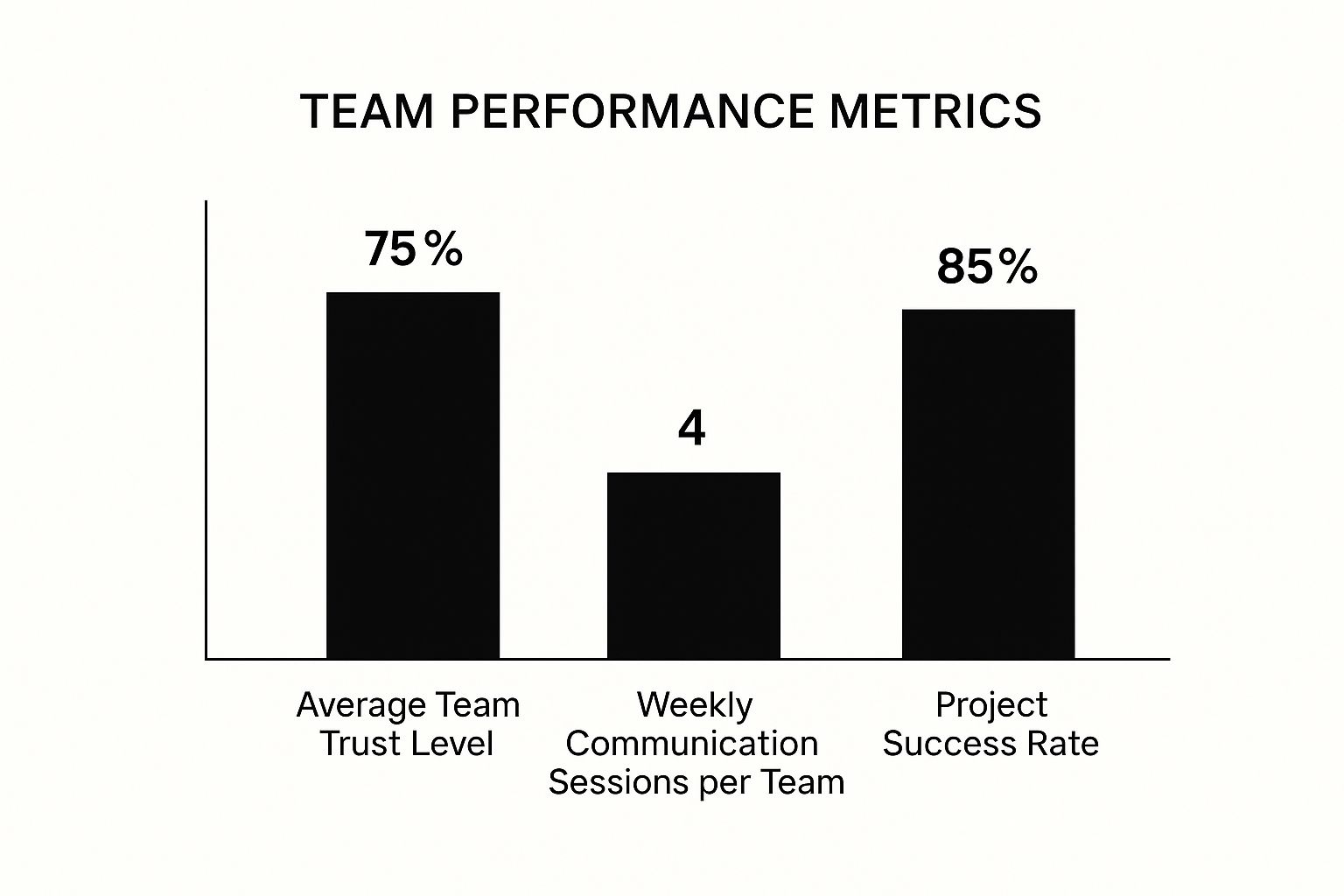Every high-performing team I've ever seen has one thing in common: a clear, compelling purpose. It's their 'North Star', that single guiding principle that informs every decision, every line of code, and every project. This isn't just about having a vapid mission statement on a poster; it's about a real, tangible goal that motivates, aligns, and empowers every single person on the team.
Defining Your Team’s North Star

Before you even think about hiring, you need to give people a powerful reason to show up and do their best work. Vague objectives just lead to scattered, disconnected efforts. But a sharp, well-defined purpose acts like a gravitational pull, aligning everyone’s work toward a single, meaningful outcome.
Let’s get practical. A software development team could have the goal to "build a new CRM platform." It's functional, certainly, but it's hardly inspiring.
Now, consider this instead: "Create a CRM that helps small businesses save 10 hours a week on administration, so they can focus on growth." See the difference? The second version connects their daily grind to a real-world impact. That kind of clarity is magnetic, attracting top talent who want to be part of the journey, not just collect a pay cheque.
Get Beyond the Mission Statement Plaque
We've all seen them—generic mission statements gathering dust on an office wall. A real North Star is an active, operational guide. It’s the filter for all your strategic decisions. When the team hits a crossroads, they should be able to ask, "Does this move us closer to our North Star?"
To craft a purpose that truly sticks, it needs a few key ingredients. It must be:
- Specific: Everyone needs to know exactly what success looks like in measurable terms.
- Ambitious: It should be a challenge that pushes the team to grow.
- Customer-centric: Always anchor it to the value you're delivering to the end-user.
- Memorable: It has to be simple enough for anyone to recall and repeat.
A cybersecurity team’s purpose, for example, could be "to become the most trusted defence for our clients' digital assets." That simple phrase guides everything they do, from choosing new security tools to how they handle a major incident.
A well-defined purpose doesn't just tell a team what to do; it provides the intrinsic motivation for why their work matters. This shared understanding is the bedrock of a high-performing workplace culture.
Making It Personal
For a North Star to really work, each person has to see how their specific role connects to it. It's a leader's job to constantly draw that line from daily tasks back to the bigger picture. This is what builds true ownership and accountability.
This sense of shared purpose is also a cornerstone of your company's environment. If you want to dig a bit deeper, we've shared more on what makes a great workplace culture and why it matters from our insights.
At the end of the day, a team anchored by a powerful vision is more resilient, focused, and driven. They don’t just tick off tasks; they work together to achieve something meaningful. Nailing this is the first, and most critical, step in building a team that truly excels.
Recruiting Beyond the CV

With your North Star set, it's time to find the right people to navigate towards it. High performance isn't just about what someone knows; it’s about their mindset, how they collaborate, and whether they have that genuine spark to make a difference. I've seen countless times how a traditional CV falls short—it tells you what a candidate has done, but it reveals nothing about how they did it or if they have the grit to thrive in your team's culture.
To build a team that truly excels, your recruitment process needs to go deeper. It’s about uncovering the soft skills and behavioural traits that separate the good from the great. This means shifting your focus from a simple checklist of qualifications to a more well-rounded evaluation of a candidate's potential.
Craft Job Descriptions That Attract Achievers
Your job description is your first handshake with potential talent, so it needs to do more than just list duties. It has to sell the mission. Don't lead with a dry list of 'must-have' skills. Instead, start with the 'why'. Frame the role within the context of your team's purpose and the real-world impact the new hire will make.
For example, a typical description might say, "Seeking a senior developer proficient in Python and AWS."
An achievement-oriented one sounds completely different: "Join us to build a cloud platform that will redefine how Australian startups manage their data. You’ll use your expertise in Python and AWS to solve complex architectural challenges that matter." See the difference? This approach attracts people motivated by impact, not just a job title. For more tips on this, you can learn about attracting top tech talent to your company from our guide.
Use Behavioural Questions to Uncover True Potential
Behavioural interview questions are, without a doubt, your best tool for looking beyond technical skills. They require candidates to draw from past experiences, which gives you a clear window into their problem-solving process, their collaborative instincts, and how they handle pressure.
So, instead of asking something generic like, "Are you a good team player?", dig deeper with questions like these:
- To gauge collaboration: "Tell me about a time you had a significant disagreement with a colleague on a project. How did you handle it, and what was the outcome?"
- To test problem-solving: "Describe a complex technical problem you faced where the solution wasn't obvious. Walk me through your process for figuring it out."
- To check for resilience: "Talk about a project that failed. What was your role, and what did you learn from the experience?"
These questions give you concrete evidence of how someone acts in real-world scenarios, which is a far better predictor of future performance than just about anything else.
The goal of the interview isn't just to validate skills. It's to see if a candidate’s professional DNA aligns with the high-performing culture you're building. It’s about finding people who will elevate the entire team.
Design Practical, Hands-On Assessments
Finally, swap out abstract hypotheticals for practical, real-world assessments. A well-designed technical task should be a slice of the actual work the candidate will be doing day-to-day.
For a UX designer, this could be a short task to critique and suggest improvements for an existing user flow. For a data analyst, you might give them a sample dataset and ask them to draw out key insights.
This approach gives you a realistic preview of their work, but it also shows you how they think, how they communicate their reasoning, and how they handle constructive feedback. It’s the final piece of the puzzle, helping you build a team with the depth, diversity, and drive needed to win.
Creating a Culture of Psychological Safety
A high-performing team isn't just about sharp skills and slick processes. It's built on a foundation of trust. The special ingredient here is psychological safety—a shared belief that you can stick your neck out, float a wild idea, or even admit you made a mistake without being shut down or humiliated. This is the soil where true collaboration and innovation grow.
Think about it. Without that safety net, what do you get? Silence. People keep brilliant, half-formed ideas to themselves. They hide small mistakes that eventually snowball into massive headaches. They nod along in meetings, even when they see a plan is heading for a cliff. A psychologically safe environment gives your team permission to be human, to learn out loud, and to bring their whole brain to a problem.
Turn Engagement into a Performance Multiplier
When people feel safe, they naturally become more engaged. They're invested, they care, and they're willing to go the extra mile. But here in Australia, we have a bit of an engagement problem that leaders can't afford to ignore.
The numbers are quite stark. As of April 2025, a sobering 16% of Australian employees said they were fully engaged at work—and that's actually a dip from the previous year. It gets even more concerning when you look at different work models. Hybrid workers sit at 15% engagement, while fully remote workers plummet to a worrying 7%. If you're serious about building a high-performing team, tackling this engagement gap is non-negotiable. You can dig into the complete report on Australian workforce engagement trends from ADP Research.
Psychological safety isn't about being 'nice' all the time. It's about being able to give tough, honest feedback, admit when you've dropped the ball, and learn from it together. It's the secret sauce for any team trying to solve genuinely hard problems.
The connection between these elements—trust, open communication, and team success—is crystal clear.

This just goes to show how fundamental trust and good communication are. They aren't soft skills; they're directly tied to successful outcomes.
Actionable Strategies for Building Trust
You can't just wish this kind of culture into existence; you have to build it, brick by brick. And it all starts with the leader. The most powerful thing you can do is show a bit of vulnerability yourself. Admit when you don't have the answer. Own up to a mistake. That single act gives everyone else permission to do the same.
Here’s a practical look at what it takes to build a foundation of psychological safety. The table below breaks down the key drivers and what leaders can do to actively cultivate them.
Key Drivers of Psychological Safety in Teams
| Component | Leader's Role | Practical Example |
|---|---|---|
| Vulnerability | Model humility and admit mistakes openly. | "I made the wrong call on that feature prioritisation. Let's regroup and figure out a better path forward based on what we've learned." |
| Inclusion | Actively solicit input from everyone, especially quieter team members. | "Sam, we haven't heard from you yet. I'd love to get your perspective on this, as you have the most context on the back end." |
| Constructive Conflict | Frame disagreements as a shared search for the best solution. | "I see we have two different approaches here. Let's whiteboard the pros and cons of each. This isn't about winning, it's about finding the smartest way." |
| Learning Mindset | Treat failures as data points and opportunities for growth. | Instead of asking "Who's to blame for the outage?", ask "What can we learn from this, and what process can we add to prevent it from happening again?" |
By focusing on these areas, you move beyond just talking about safety and start actively building it into your team's DNA.
Here are a few more tangible ways to foster that trust:
- Make One-on-Ones Count: This time is sacred. Use it for coaching and genuine listening, not just a verbal status report. Ask questions like, "What's one thing that’s frustrating you right now?" or "Where could you use my help to unblock you?"
- Reframe Feedback: Position feedback as a gift for growth, not a personal attack. Encourage your team to give feedback to each other (and to you!) by setting up clear, respectful ground rules for how it's done.
- Celebrate the Lessons from Mistakes: When a project derails or a bug makes it to production, the first step should be a blameless post-mortem. The focus isn't on "who messed up?" but on "what did we learn?"
At the end of the day, leading with empathy is what ties it all together. This approach doesn't just build a safe environment; it creates stronger, more resilient bonds within the team. We explore this further in our article on why compassion is a powerful management tool. When you champion these behaviours, you're not just managing a group of people—you're cultivating a powerhouse team ready for anything.
Fuelling Growth with Continuous Development
High performance isn't a destination you arrive at. It’s a moving target, especially in tech. What made your team great six months ago is probably just standard practice today. This is why building a culture of continuous development isn't just some feel-good extra—it's the engine that keeps you ahead of the game.
Stagnation is the silent killer of great teams. Without a real commitment to learning, even your sharpest people will find their skills getting dull and their competitive edge vanishing. The trick is to stop thinking about training as a once-a-year event and start weaving it into the fabric of your team's weekly rhythm.
Unfortunately, many Australian organisations are falling behind here. Workplace training is essential, yet participation has dropped by a concerning 14% across most industries since 2007. That's a huge gap in skills and capabilities that leaders need to close, and fast. The CEDA report on Australia's training needs digs into this issue further if you're keen to understand the landscape.
Creating Personalised Growth Roadmaps
Forget the one-size-fits-all training matrix. It just doesn't work. The best development strategies are deeply personal, connecting an individual's career goals with what the team needs to achieve. When you get this right, you create a powerful win-win: your people feel valued and see a future, and the team gets the exact skills it needs to deliver.
This all starts with genuine conversations in your one-on-ones. Go beyond status updates and ask good questions. Things like, "What's one skill that would make your work here more impactful?" or "If you could dive deep into any part of our tech stack, what would it be?"
The answers you get are the foundation of a practical growth plan. This doesn't need to be a bureaucratic, 10-page document. It can be as simple as a shared list of focus areas for the next quarter. The key is that it's a two-way street. When your team member has a real say in their development journey, they'll own it.
A team that learns together, grows together. The best leaders don't just manage tasks; they act as development coaches, consistently looking for opportunities to stretch their team's capabilities and build collective expertise.
Weaving Learning into the Daily Workflow
"We don't have time for training" is a common excuse, but it misses the point. The most effective learning happens on the job, not in a classroom. It needs to be integrated directly into the flow of work, not treated as a separate, inconvenient activity.
Here are a few simple but powerful ways to make this happen:
- Peer-to-Peer Mentoring: Got a tricky feature to build? Pair a senior dev with a junior one to tackle it together. The real-world guidance they get from this is worth more than any online course.
- Learning Sprints: Block out a bit of dedicated time. Maybe it's one Friday afternoon a month. Let the whole team get their hands dirty with a new tool, framework, or technique. At the end of the session, everyone shares what they discovered.
- Knowledge-Sharing Sessions: Get your team teaching each other. Encourage informal "lunch and learn" style presentations on topics they're passionate about. It’s a fantastic way to spread knowledge, and it also helps build people's confidence and positions them as go-to experts.
By making practices like these a regular part of how your team operates, you shift development from an annual chore into a non-stop cycle of improvement. This is how you build a team that doesn't just perform, but constantly evolves.
Measuring Performance That Truly Matters

You’ve defined your team's purpose, brought the right people on board, and built a culture where they feel safe to grow. So far, so good. But how do you actually know if all that effort is translating into high performance?
This is where meaningful measurement comes in, and frankly, it’s where a lot of leaders stumble. It's easy to fall back on simplistic metrics that look good on a spreadsheet but don't tell the full story.
The trap is measuring busyness instead of impact. Counting lines of code or the number of tickets closed can incentivise the wrong behaviours. Your goal should be to find a balance—tracking tangible results while also keeping a finger on the pulse of your team's health and momentum.
Moving Beyond Vanity Metrics
The key to effective measurement is asking the right questions. Instead of "How much did we get done?", a much better question is, "How much value did we actually deliver?". This simple shift forces you to tie every Key Performance Indicator (KPI) directly back to your team's core mission and the wider business goals.
For an IT or digital team, this could mean tracking things like:
- System Uptime: This is a classic for a reason. It's a direct reflection of the stability and reliability you’re providing to the rest of the business.
- Mean Time to Resolution (MTTR): When things do go wrong (and they always do), how quickly and effectively does your team solve the problem and get things back on track?
- Customer or End-User Satisfaction Scores: Nothing beats direct feedback. Are the people using your systems and services happy with the quality of your work?
This focus on real outcomes is particularly relevant in Australia right now. We're facing some serious productivity challenges—in fact, recent figures show productivity growth is at a 60-year low, with the market sector up by a tiny 0.07%. Experts agree that to turn this around, businesses need to ditch the old ways and embrace outcome-based assessments that properly identify who the real high performers are. You can read more from HR experts on navigating Australia’s productivity challenges.
Making Performance Reviews a Coaching Opportunity
Let's be honest: the annual performance review is often dreaded by everyone involved. It doesn't have to be that way. In the best teams I've worked with, these conversations aren't a final verdict; they're just one part of an ongoing dialogue about growth and impact.
A great performance review should contain no surprises. It’s a collaborative coaching session that recaps a year's worth of continuous feedback, celebrates wins, and sets a clear, co-created path for the future.
You can completely transform your reviews by changing the questions you ask. Instead of just rehashing the past, make it forward-looking. Try asking things like, "What support do you need from me to hit your goals next quarter?" or "What's one area you're excited to develop, and how can we make that happen together?".
This simple tweak turns a review from a retrospective report card into a strategic planning session. It builds accountability, clarifies expectations, and keeps individual growth locked in sync with the team's mission. When you start measuring what actually matters—outcomes, team health, and personal growth—you create a cycle of high performance that just keeps building on itself.
Common Questions on Team Performance
Building a high-performing team isn't always a straight line, and along the way, leaders often run into the same hurdles. Let's tackle some of the most common questions I hear from managers trying to get their teams firing on all cylinders.
How Do You Turn Around an Underperforming Team?
When a team is struggling, the first instinct is often to make big, sweeping changes. Resist that urge. The real work begins with a proper diagnosis.
Start by having confidential, one-on-one chats with everyone on the team. Your goal is to understand their perspective on what’s blocking them. More often than not, you'll find the root cause is a lack of clarity, not a lack of effort.
Once you have a clearer picture, revisit the team's goals. Is their purpose crystal clear? Ambiguity is the enemy of performance. From there, aim for a few quick, achievable wins. Nothing builds momentum like success, no matter how small. This helps to rebuild confidence. Finally, you need to address any skill gaps with proper support and double down on creating a space where people feel safe to talk about challenges without fear of being penalised.
What Is the Leader's Most Important Role in a High-Performing Team?
Your most critical role is to be a barrier remover and a culture champion. It’s less about directing every move and more about shielding the team from organisational bureaucracy so they can actually get work done.
Your success as a leader isn't measured by your own output, but by the autonomy and success of your team. The goal is to facilitate, coach, and empower them to do their best work.
This is a real shift in mindset. You move from being the manager who directs to the coach who guides. It's about asking the right questions, not always having all the answers. Your job is to clear the path and let your talented people run on it.
How Long Does It Typically Take to Build a High-Performing Team?
There's no magic number here—it's definitely a marathon, not a sprint. Based on my experience, you can expect to see significant, tangible progress within 6 to 12 months.
It often breaks down something like this:
- Months 1-3: This is all about laying the foundation. You’re focused on building trust, making sure roles are clearly defined, and getting everyone aligned on a shared purpose.
- Months 3-9: Now you’re in the thick of it. This phase is all about learning to navigate conflict constructively and ironing out the kinks in your workflows. You’ll see processes start to click.
- Months 9+: True high performance—where the team is largely self-sufficient, innovative, and consistently smashing its goals—often takes a year or more to really solidify.
The key isn't how fast you get there. It's the consistent, daily effort you put into cultivating the right environment for your people to do their best work.
If you are looking for a trusted, high-performing recruitment partner to find the right people for your digital and IT teams, Redwolf Rosch has the deep expertise to help. Get in touch for an introductory discussion today.
 Submit CV
Submit CV Submit vacancy
Submit vacancy  Call for a Candidate
Call for a Candidate